
Mysore, officially Mysuru, is the second-most populous city in the southern Indian state of Karnataka. It is the headquarters of Mysore district and Mysore division. As the traditional seat of the Wadiyar dynasty, the city functioned as the capital of the Kingdom of Mysore for almost six centuries. Known for its heritage structures, palaces, and its culture, Mysore has been called the "City of Palaces", the "Heritage City", and the "Cultural Capital of Karnataka". It is one of the cleanest cities in India according to the Swachh Survekshan.

The Wadiyar dynasty, also referred to as the Wadiyars of Mysore, is a late-medieval/early-modern South Indian Hindu royal family of former kings of Mysore from the Urs clan originally based in Mysore city.

The Chamundi Hills are located 13 km east of Mysore, Karnataka, India. The name comes from the Chamundeshwari Temple at the peak. The average elevation is 1,060 metres (3,480 ft).

Mysore Palace, also known as Amba Vilas Palace, is a historical palace and a royal residence. It is located in Mysore, Karnataka, India. It used to be the official residence of the Wadiyar dynasty and the seat of the Kingdom of Mysore. The palace is in the centre of Mysore, and faces the Chamundi Hills eastward. Mysore is commonly described as the 'City of the Palaces', and there are seven palaces including this one. However, the Mysore Palace refers specifically to the one within the new fort.

Mysore pak is an Indian sweet prepared in ghee. It originated in the city of Mysore, one of the major cities in the Indian state of Karnataka. It is made of generous amounts of ghee, sugar, gram flour, and often cardamom. The texture of this sweet is similar to a buttery and dense cookie. It is also popular in the neighboring countries Pakistan and Bangladesh.

Srikanthadattā Narasimharājā Wadiyar was an Indian royal, politician, and fashion designer, who served as Member of Parliament from Mysore. He was the son of Maharaja Jayachamarajendra Wadiyar, the last king of Mysore.
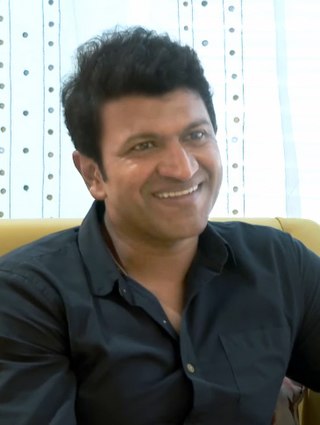
Puneeth Rajkumar, affectionately known as Appu by his fans, after his first lead role in the movie Appu, was an Indian actor, philanthropist, playback singer, television presenter and producer, who worked in Kannada cinema. He was the youngest son of legendary actor and matinee idol Dr. Rajkumar. He was one of the most popular actors in Kannada cinema. He appeared as a lead in 32 films. As a child, he appeared in many films. His performances as a child actor in Vasantha Geetha (1980), Bhagyavantha (1981), Chalisuva Modagalu (1982), Eradu Nakshatragalu (1983), Bhakta Prahaladha (1983), Yarivanu (1984) and Bettada Hoovu (1985) were praised. He won the National Film Award for Best Child Artist for his role of Ramu in Bettada Hoovu. He also won Karnataka State Award Best Child artist for Chalisuva Modagalu and Eradu Nakshatragalu. Puneeth's first lead role was in 2002's Appu. In a career spanning three decades, he has won one National Film Award, four Karnataka State Film Awards, six Filmfare Awards South and five SIIMA awards. He was conferred with the Doctorate by Mysuru University. The Karnataka Government conferred the state's highest civilian award, Karnataka Ratna, to Puneeth Rajkumar on 1 November 2022, posthumously.
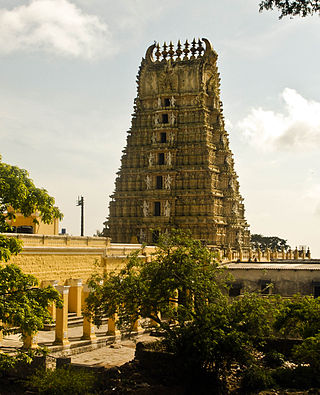
The Chamundeshwari Temple is a Hindu temple located on the top of Chamundi Hills about 13 km from the palace city of Mysuru in the state of Karnataka in India. The temple was named after Chamundeshwari or, the fierce form of Shakti, a tutelary deity held in reverence for centuries by the Maharaja of Mysuru.

Mysore Dasara is a state festival in the state of Karnataka in India. It is a 10-day festival, starting with nine nights called Navaratri and the last day being Vijayadashami. The festival is observed on the tenth day in the Hindu calendar month of Ashvina, which typically falls in the Gregorian months of September and October.
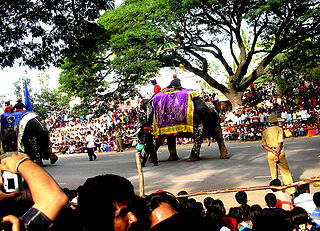
Elephants are an integral part of the Mysore Dasara Festival. The elephants form the core of the Mysore Dasara procession on the Vijayadashami day. The lead elephant carries the Golden Howdah with the Goddess Chamundeshwari in it. The Golden Howdah weighs 750 kilograms and is made of gold.
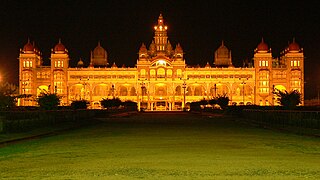
Mysore is a city in the state of Karnataka, India. It is known as the cultural capital of Karnataka. Mysore was the capital of the Wodeyar kings who ruled over the Mysore Kingdom for many centuries. Wodeyars were great patrons of art and music and have contributed significantly to make Mysore a cultural centre. Mysore is well known for its palaces, museums and art galleries and the festivities that take place here during the period of Dasara attract a worldwide audience. Mysore has also lent its name to popular dishes like Mysore Masala Dosa and Mysore Pak. Mysore is also the origin of the popular silk sari known as Mysore silk sari and has also given rise to a popular form of painting known as Mysore painting.
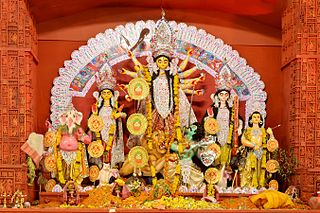
Ayudha Puja is a Hindu observance that falls on the ninth day of the bright half of the moon's cycle of 15 days in the month of September/October, popularly a part of the Navaratri festival. While the Navaratri festival is observed all over the country, the festivity that is widely marked as Ayudha Puja possesses slight variations of veneration and practices across India.
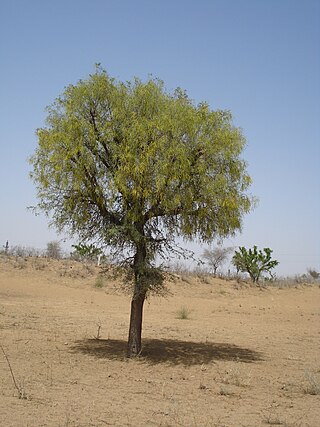
Prosopis cineraria, also known as ghaf, is a species of flowering tree in the pea family, Fabaceae. It is native to arid portions of Western Asia and the Indian Subcontinent, including Afghanistan, Bahrain, Iran, India, Oman, Pakistan, Saudi Arabia, the United Arab Emirates, and Yemen. Its leaves are bipinnate. It can survive extreme drought. It is an established introduced species in parts of Southeast Asia, including Indonesia.

Sir Mokshagundam Visvesvaraya, also referred to by his initials, MV, was an Indian civil engineer, administrator, and statesman, who served as the 19th Dewan of Mysore from 1912 to 1918.
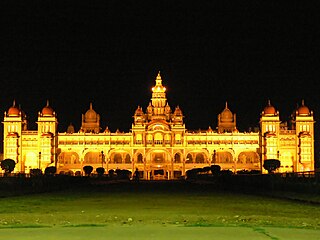
The Mysore Dasara 2013 is the 403rd edition of the annual royal festive gala event, a show of pomp and tradition that is held in the Mysore city in Karnataka, India for 10 days. The festival is called the Navaratri (meaning nine nights or Dussehra or Vijayadashami which conforms to the bright half of the month of Ashvin, from pratipadathithi to navamithithi in the Hindu calendar corresponding to 5 to 13 October during 2013. The festival is also called Nada Habba in Kannada language. The first day of the nine-day festivity started on 5 October with the traditional and religious special puja performed to Goddess Chamundeshwari in the Chamundi Temple on top of the Chamundi Hill, which forms the backdrop to the city; the temple was beautifully decorated with flowers and tourist from Gujarat, Rajasthan and other states enthralled the audience with their bhajan singing. On this occasion, floral tribute wa offered to the goddess by Jnanpith Award winner Chandrashekhara Kambara and festivities will continue for ten days. The ninth day of the festival is a special event called the Mahanavami when the royal sword is worshipped and taken in a procession of elephants, camels and horses. The festival concludes on 14 October on the dashami day with the grand finale of Jambusavari with the idol of Chamundeshawri set in a golden howdah mounted on a richly caparisoned elephant. The procession is taken through the streets of the city and ends in the Banni Mantap where, in the evening, a torch light parade is held. Symbolically, the festival represents the victory of good over evil.
Raja Wodeyar I was the ninth maharaja of the Kingdom of Mysore. He was eldest son of Chamaraja Wodeyar IV, the seventh maharaja of Mysore. He ruled from 1578, after his cousin Chamaraja Wodeyar V's death, until his death in 1617.
The dewan of Mysore was the de facto chief executive officer of the Government of Mysore, ex officio chairman of the Dewan's Council, and the prime minister and royal adviser to the maharaja of Mysore. The role evolved in title and duties since the foundation of the fiefdom of Mysore in 1350 and its proper reformation into a kingdom in the following centuries until the kingdom's full abolishment in 1950. With the constitution of India into a republic in 1950, the position was replaced by Chief Minister of Mysore.
Mysore North is a cluster of suburbs in the northern side of Mysore. City is divided as Northern and Southern clusters or blocks for administration Mysore North hosts separate Zone for many Government offices like Block Educational Officer, Sub-Registrar's Office and many other departments.
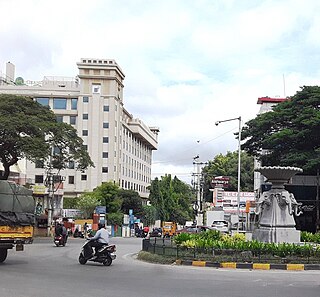
Hanumanthanagar is a locality in Bannimantap, a suburb of Mysore coming on the Northern side of the city. It is part of Mysore district in Karnataka state of India. Hanumanth Nagar is famous for the Jumbo Savari with the golden Howdah, a part of Mysore Dasara, which marks an end of the procession in Bannimantap via Highway Circle of Hanumanth Nagar.
















